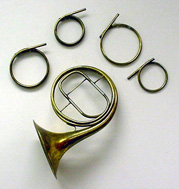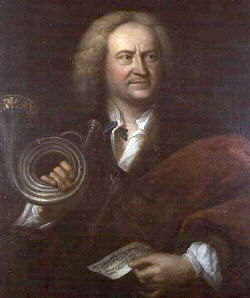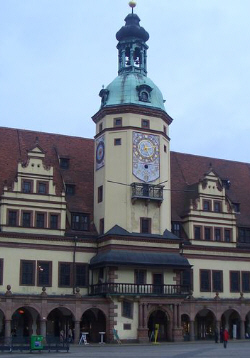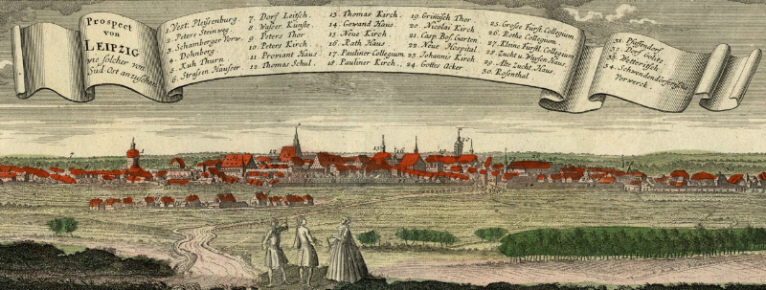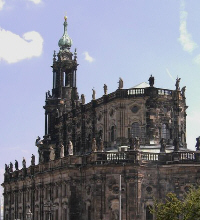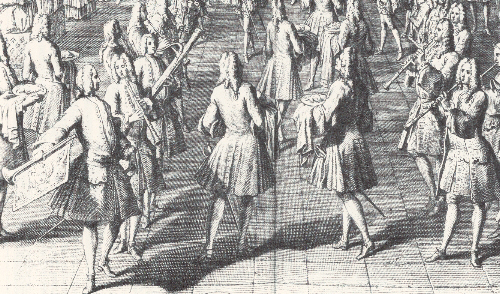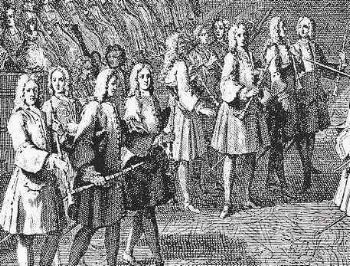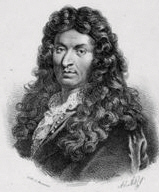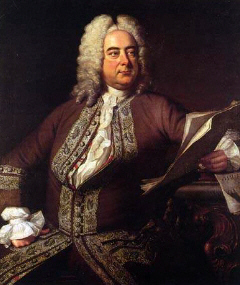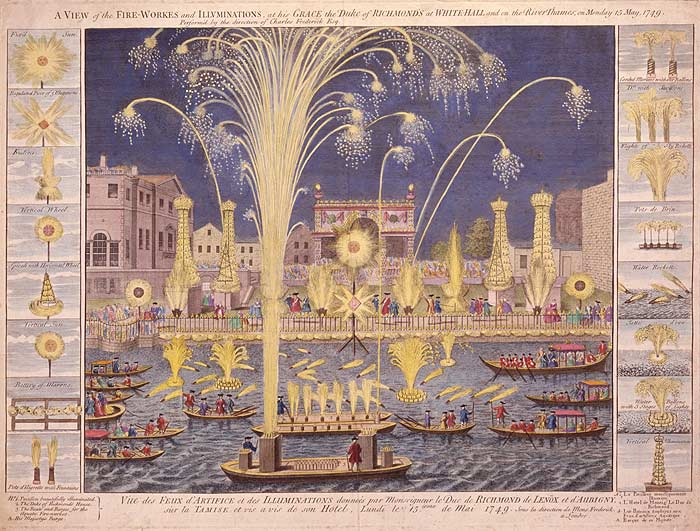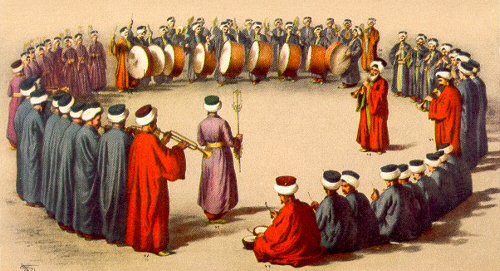3
|
||
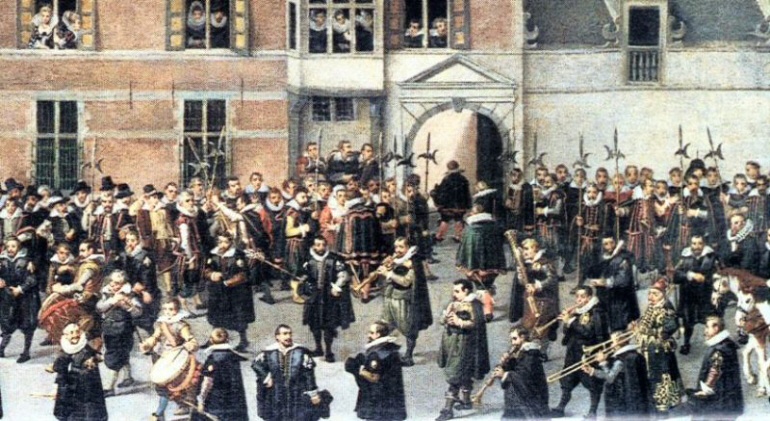 Archduchess Isabelle and Archduke Albert at the procession of the maids of the Sablon, Antoon Sallaert (1615) 1 |
||
That which did please me beyond anything in the whole world was the wind-musique. During the Baroque, the wind band increased its visibility in a variety of venues--from municipal bands in Central Europe to the court of Louis the XIV of France. The oboe was held in high esteem and the trumpet reached a level of virtuosity not previously heard. Military music became increasingly important as rulers from England to the Ottoman Empire maintained standing armies. And at the twilight of the age the greatest wind band piece to date caused quite a stir in London. The Baroque was a period of startling transition for instrumental music, beginning with the synthesis of music and drama that became known as opera. In the twilight of the Renaissance a group of intellectuals known as the Florentine Camerata worked to re-establish the format for drama as practiced in Greek antiquity, with the inclusion of music in the manner they perceived it might have been performed. The problem they encountered was that polyphony, with its multi-voiced texture, was unsuitable for drama, so the concept of monody (single melodic line) and homophony (single melodic line with accompaniment) came into practice. This greatly facilitated the dramatic flow as the text now took precedent over the music. The instrumental accompaniment for this new art form continued to foster the concept of specified instrumentation, which, in turn, foreshadowed the development of the symphonic orchestra. By the late Baroque, symphonic form began to evolve, securing a viable ensemble medium for winds and strings outside of the opera pit. Symphonic form was an outgrowth of the Neapolitan Overture designed by Allesandro Scarlatti. This single movement form was divided into three sections of contrasting tempo (fast, slow, fast) which eventually developed into the first, second, and fourth movements of the Classical symphony as developed and refined by the composers Haydn, Mozart, and Beethoven. MONTEVERDI'S ORFEONo composer represents the transition from the Renaissance to the Baroque better than Claudio Monteverdi does. A survey of his madrigals shows a most abrupt transition from polyphony to homophony, and his opera Orfeo, first performed in 1607, stands as the first masterpiece of the early Baroque. Orfeo combined elements of the old style as well as the new. On the one hand it was written in the new homophonic style, as established by the Camerata. But on the other hand, the instrumentation, while showing certain innovations, still hearkened back to earlier customs. The size and instrumentation of the orchestra for Orfeo was unprecedented. The strings were a combination of the viol and violin families, while the winds consisted of a small flute, two cornetti, four trombones and one trumpet with three muted trumpets. To round out the instrumentation were two bass lutes, a small harp, a portative organ, two organs with wooden pipes, and a harpsichord and spinet. However, despite the large personnel and diversity of color, the instruments were mostly used in smaller groups or consorts with varied keyboard accompaniment rather than in large tutti sections. Nevertheless, the orchestra of Orfeo, at least in size, foretold the orchestra to come. - Back to top -CHANGE AND DEVELOPMENT OF WIND AND STRING INSTRUMENTSTrombonesFor centuries the trombone was the only brass instrument that could play chromatically. The trumpet and horn were limited to the notes produced naturally through the overtone series until the invention of the valve early in the 19th century. So it is ironic that during the Baroque period, when the trumpet and horn enjoyed increasing favor, the trombone, despite its flexibility, endured a period of limited use. It enjoyed some prestige from the "tower music" played in various German municipalities as well as being a component of some church music. It also saw limited use in the opera pit. But it would not find its way into the symphonic repertoire until the dawn of the Romantic period and Beethoven's Symphony No. 5.During the Baroque certain instruments fell into disuse while others rose in popularity. For example, mainstays such as the recorder and cornetto families declined while the oboe and bassoon became arguably the most popular woodwind instruments of the era. The horn also enjoyed popularity, while the trumpet entered into a somewhat "golden age" of performance. More significantly, by the late 17th century the violin family enjoyed such acceptance as to be regarded as the foundation for the Classical and Romantic orchestra, while the viol family, with the exception of the string bass, passed into obscurity. Oboe and BassoonThe oboe is the ultimate refinement of the medieval shawm. As mentioned in the last chapter, the shawm was a raucous-sounding instrument that was usually made of one piece of wood, conical in shape, with a trumpet-like bell at the lower end. It had six finger holes, and ranged from just over one foot to nine or ten feet in length. The double reed that produced the sound was held in place by a device called a pirouette. The player's mouth would press against the crescent -shaped rim of the pirouette so as to create an airtight wind chamber. The subsequent blowing into the pirouette created a most raucous sound since the reed vibrated without the aid of any lip pressure against the side of the reed.1 Early in the 17th century Mersenne in his Harmonie Universelle described two types of shawms--the Hautbois de Poitou which corresponds to the shawm described above, and the treble hautbois which appears to be a precursor to the modern oboe. This instrument used no pirouette, and had eight finger holes in addition to what appear to be two tuning holes. Not long after this (c. 1660-1670) the oboe emerged as the jointed, more cylindrical, keyed instrument which formed the nucleus of the woodwind section for the second half of the seventeenth century.2 The earliest evidence of the bassoon is found in the middle of the 16th century in Italy and Germany. Undoubtedly formed to create a bass voice for the oboe or shawm, the early bassoon was made of one piece of wood with two bored out passages connected at one end. This allowed the player to handle a less unwieldy instrument, albeit one which required awkward fingerings, to say the least. It appears that the predecessor to the modern oboe originated in France and spread to England and Germany shortly thereafter. One practice that suggests this is the combination of French and German in the term Hautboisten common in Germany. The popularity the oboe enjoyed during the Baroque is best indicated in the twelve-member oboe and bassoon band of Louis XIV known as Les Grande Hautbois. Many customs of the court of Louis XIV were imitated throughout Europe, and by the turn of the eighteenth century the Hautboisten band was imitated by a number of the great residences of Germany.3 A typical instrumentation for such a band consisted of two soprano oboes, a tenor oboe known as a taille, and bassoon. - Back to top -HornBy the end of the 17th century fundamental changes in the makeup of the horn led to its increasing popularity and adaptability. First, the length of the horn grew to as much as twelve feet, allowing the player access to the consecutive scale steps of the fourth octave of the harmonic series. Also, the shape was altered from the close-wrapped multi-coil style to one of an open hooped shape with a noticeably larger bell. Early in the eighteenth century a series of crooks were provided which allowed the player to change the length of the horn, thus affording the opportunity to change key centers. Collectively, these adaptations made the horn a more pleasant sounding, flexible instrument.4 The horn eventually became the accepted brass instrument to complement woodwinds. By the early eighteenth century horns were common in German bands such as the Bavarian military (6 oboes, 2 horns in 1722), and the Sächsische Variante (2 oboes, 2 horns, 2 bassoons, c. 1730). In a performance for the Nuremberg Carpenter's Guild in 1731 there were three separate bands each consisting of 3 oboes, 2 horns, and 1 bassoon.5 These ensembles undoubtedly were precursors to the Harmoniemusik style of the Classical period (see chapter 4) - Back to top -Baroque TrumpetFor centuries, the trumpet was considered an instrument exclusive to the court, specifically the property of the ruler of highest rank who was usually the king. During the Baroque era the art of trumpet playing evolved to a high level of technical virtuosity achieved by a select group of players who maintained their exclusivity through guild membership. As early as 1623 an Imperial Guild of Court and Field Trumpeters and Court and Army Kettledrummers was formed in the Holy Roman Empire for the purpose of regulating instruction. This limited the number of performers, as well as placing restrictions on locations of performance and on who was allowed to perform. The Elector of Saxony was named as patron of the guild. While other countries outside the empire did not necessarily maintain comparable guilds as such, trumpet playing enjoyed similar status throughout Europe.6 Use of MutesTrumpet players are accustomed to playing with a variety of mutes as designated in their music, whether it be symphonic, jazz, or solo literature. But perhaps the earliest designation for muted playing comes from a 17th-century military order. The signal la sourdine was an order to march "with little noise". The directive for such practice was explained thus:...the mute is used when there is a risk of being discovered by the enemy or when it is wished to surprise them, as also when it is desired to decamp or secretly withdraw... 1 To enforce the privileges for the newly formed guild, Holy Roman Emperor Ferdinand II decreed in the same year: No honourable trumpeter or timpanist shall allow himself to be employed with his instrument in any way other than for religious services, Emperors, Kings, electors and Princes, Counts, Lords and Knights and nobility, or other persons of high quality: It shall also be forbidden altogether to use a trumpet or a timpani at despicable occasions; likewise the excessive nocturnal improper carousing in the streets and alleys, in wine and beer houses. He who transgresses in this way shall be punished.7 No less was to be expected from a class of musicians who not only wore the feather of nobility in their caps, but were also provided with horses and personal servants. Trumpeters were expected to travel with their lords so as to provide fanfares whenever the lord entered a town or castle. They also relayed messages in times of war and political crisis as well as participating in political intrigues.8 In Germany as well as France trumpeters were required in the military, especially in the mounted cavalry. Trumpets led the way in military parades, but during battle they were positioned at the rear of the battle alongside the commander, ready to communicate the various orders of movement such as the standard calls to the saddle and the charge, which were required to maintain order and timing. Trumpet masters, jealous to keep their high standing, maintained a veil of secrecy over their guild by playing from memory and by teaching new guild members by rote. They were especially secretive about techniques such as flutter tonguing, double and triple tonguing, trilling, and high tessitura playing, as well as instrument construction such as mouthpiece design and tubing for pitch changes.9 Trumpets were also active in other forms of music that did not necessarily involve the nobility directly. During the Baroque several forms of entertainment emerged in which war imitated art, and vice versa. One example is the concept of "battle choreography" as described in Möller's Trilekunst zu fuss (Infantry Drill) published in 1672. Here the author provides minute instructions for placing foot soldiers in a pattern representing the arms of the imperial city of Lübeck. Another example was the tournament, where competition was staged with music and the proceedings took on a sense of theater with allegorical tones. Rifles had now become the common elements of war, rendering the weaponry and conflict that the tournament represented obsolete. Nevertheless, tournaments remained a popular activity--and the trumpet, being the musical signature of the nobility, was an integral part of this pastime. Equestrian BalletsIn time, tournaments gave way to military or equestrian ballets. In Italy, early examples even incorporated elements of opera. Ferdinand III introduced the practice in Austria where the Spanish school of riding can still be enjoyed today in the performances of the Lippizaner stallions. In France, Louis XIV was also fond of these horse ballets, known as Caroussels. Since most trumpet music was improvised, few examples survive from these engagements.On occasion, composers also wrote less programmatic music for the trumpet. Some specific examples include Praetorius's setting in 1618 of In dulci jubilo (Polyhymnia panegyrica et caduceatrix no. 34) using a six-part ensemble in a chorale style. Franz Biber wrote two sonatas for six- and eight-part trumpet ensembles with kettledrums and continuo. Also worthy of mention is Michel Corrette's Divertissement Op. 7 for two trumpets. As technical prowess improved, composers wrote music incorporating high tessitura or clarino playing in their trumpet parts. The design of Baroque mouthpieces facilitated this style of playing with a rim that was flatter and wider, allowing for greater endurance. It also had a pronounced edge between the cup and the throat that allowed for (1) bending the pitch on out-of-tune notes, as well as (2) lending a certain brilliance to the tone. Earlier in the Baroque, players were reaching the 16th partial with regularity, eventually reaching into the fourth or fifth octave late in the Classical period, as heard in the concertos of Michael Haydn, Reutter, F. X. Richter, and Joseph Riepel. Bach featured the skill of the celebrated player Gottfreid Reiche (senior Stadtpfeifer in Leipzig until his death in 1734) in many of his works, though the second Brandenburg Concerto preceded their acquaintance, and the Christmas Oratorio was performed by his successor.10 As the Baroque era declined, musical taste dictated a style different from the brilliant virtuosity demanded from trumpet players. Also, royal wealth and status declined, thanks in part to the French Revolution, making the financial status of the trumpet guild increasingly shaky. The guild was dissolved in Berlin by 1810, and the guild in Saxony, after some 200 years of existence, followed suit in 1831. - Back to top -STADTPFEIFER AND MUSIC IN LEIPZIGMunicipal wind bands played a significant role in the cultural life of German cities during the Baroque. Most of these town musicians came under the jurisdiction of the town council and were known as Ratsmusik--Rat being the German word for council. The Stadtpfeifer were the paid musicians whose primary duty was to play concerts from the town hall tower at various times of day (thus the name "tower music"). They also participated in religious and civic ceremonies, played for dances, and alerted the town to the approach of an enemy or an outbreak of fire. The reasons for this particular German practice were at least twofold. First, the public held wind music in high esteem, deeming it a particularly noble sound. Second, Germany was still a fragmented country with many smaller kingdoms and city-states, each responsible for the social, cultural, and physical life of its people. So the Ratsmusik provided a public relations opportunity to enhance the cultural life of the community. Winds vs. StringsInto the middle Baroque, wind playing was still held in the highest regard. The music of brass instruments reminded the Baroque citizen of royal splendor, processions, and promotions, while string music was indicative of the dance floor or the private home.2The city of Leipzig retained records of various practices of the Ratsmusiker that provide insight into the music practice of the time. By 1650, the devastating toll of the Thirty Years' War was at an end, and Germany was finally able to return to the cultivation of commerce and artistic pursuits. Leipzig was about to enjoy the greatest century of its music history. Initially four Stadtpfeifer were employed as Ratsmusiker, serving primarily as wind players. In time three more musicians, referred to as Kunstgeiger, were hired to play the violin. Surviving records reveal much squabbling between the two groups, mostly due to the perceived inconsistencies felt by the Kunstgeiger who were subordinate to the Stadtpfeifer. The Kunstgeiger were considered apprentices to the Stadtpfeifer and were often exploited for the sake of money, having to endure an income below that of their superiors. Jealousy was the common denominator as the Stadtpfeifer, being the privileged group, received first choice for engagements outside their required duties. On occasion these two groups would band together to fight the competition presented by the Bierfiedler (fiddle players employed by beer halls). During this time string players were often considered second class citizens when compared to wind players. By 1700, another class of musician, the NeuKirchenmusiker (new church musicians) made the situation even more complicated for the city council.11 Since the Stadpfiefer and Kunstgeiger were trained simply as craftsmen, the Ratsmusik lacked the respect that organists and cantors enjoyed due to their liberal arts education. Kuhnau wrote that among one hundred Kunstgeiger, there could hardly be one who could write ten words without making a mistake, and Mattheson also had little regard for them, noting their perceived conceit and lack of education.12 In Leipzig the four Stadtpfeifers' most important regular function was to play daily from the tower at city hall at 10:00 a.m. and at various times during the evening. This function was known as Abblasen or Turmblasen. Johann Pezel, perhaps the most famous of these Stadtpfeifer, noted in the dedication of his Hora Decima that this custom was of Turkish or Persian origin, then hastily confirmed that it had now become a Christian tradition. Gottfried Reiche noted that this tower music was a symbol of joy and peace--no doubt a reference to the peace enjoyed due to the end of the Thirty Years' War.13 Since the brass instruments were provided for this function by the city, both the instruments and the music were stored in the tower. For outside employment, musicians had to provide their own instruments. In addition to the provision of music and instruments, the Ratsmusiker enjoyed other privileges, including weekly salaries, occasional extra money, and clothing. Also, until 1717, the Stadtpfeifer paid no taxes and were given free living quarters in the Stadtpfeifergäszlein (little city musician street) where they and their families all lived together in one house. While the rank of Stadtpfeifer was a lifetime position, the downside was that upon the player's death, the surviving family could be left without means of support. Also, income was precarious during times of mourning or pestilence, as music for celebrations such as weddings was curtailed for a prescribed period of time.14 On occasion, if not regularly, the Stadtpfeifer joined with the Kunstgeiger under the direction of the Cantor for church performances. Because of their versatility in playing both wind and string instruments, the combination of the two groups of musicians, coupled with student players, allowed the Cantor a respectable orchestra with which to work.15 When a musician applied for a position as a Stadtpfeifer, a complete knowledge of the Stadtpfeifer instruments was usually required. These could include trumpet, cornett, trombone, French horn (in time), bombart [German for shawm], dulcian [early bassoon], flute, oboe, plus strings. Little is available today as to textbooks or written instructions concerning the craft of the Stadtpfeifer due to the secrecy surrounding the guild. Indeed, it was most difficult to reach a high level of maturity, unless fellow musicians provided the training. Not until the Ratsmusiker tradition began to die did the first known text appear, written by Johann Ernst Altenburg.16 The eventual decline of the Ratsmusiker movement can be attributed to a couple of factors: 1. The steady influx of free and independent musicians gradually took its toll. These "strolling musicians", as represented by the Bierfiedler (violinists playing in beer halls and taverns, Dorfmusikunsten (village musicians), Schallmeyer (shawm players), and Hümpler und Stümpler ("bunglers and blunderers", a reference from their guild-slang), played at weddings, parties, and christening feasts. They were not subject to the limitations of the municipal prohibitions and could earn a salary throughout the whole year. Examples of repertoire performed in Leipzig no doubt included Pezel's Hora decima musicorum Lipsiensium (1670) written for five-part cornett and trombone ensemble, and Reiche's Vier und zwantzig neue Quatricinia (1696), written for four-part cornett and trombones. There was certainly a wealth of other literature written during the time as evidenced by the inventory lists from 1747 which included five chorale books and 122 wind pieces written by Gottfried Reiche which are now lost.18 - Back to top -COMPOSERS AND MUSIC OF CENTRAL AND EASTERN EUROPESeveral composers from Central Europe, Eastern Europe, and northern Italy are worthy of notice either for their innovative wind scoring, or simply for having written music exclusively for winds. Johann PezelJohann Christoph Pezel spent his enitre career as a German town bandsman and composer. As a Ratsmusiker, he played both wind and string instruments, but is first mentioned as a string player. In 1664, when the town of Leipzig voted to increase the size of the town band from seven to eight players, Pezel was appointed fourth Kunstgeiger. In 1670 he achieved the rank of Stadtpfeifer, a lifetime appointment, and wrote his Hora decima musicorum. This literature is certainly not "cutting edge" for its time, but what makes Pezel's music so engaging was the imaginative use of textures in alternating imitative and homophonic sections.19 Pezel's Sarabande (from another set) captures the listener's interest with simple yet effective use of descending and ascending scale lines. - Back to top -Tiburtio MassainoThe canzona, as an instrumental form, continued to have life during the early years of the Baroque era. One impressive example is the Canzona for Eight Trombones and Continuo written by Tiburtio Massaino. Massaino (or Massaini) was a somewhat shady character who, despite his connection from youth to the Augustine Order and work as a chaplain, was thrown out of Salzburg for "crimes against nature". This particular canzona appeared in the collection of canzoni per sonare that the Venetian publisher Alessandro Raverii issued in 1608. Although the music indicates two choirs, suggesting the style of St. Mark's, the music functions as one entity from beginning to end. This canzona is also significant for its specified instrumentation, a practice that had become increasingly commonplace thanks to the influence of Andrea and Giovanni Gabrieli. - Back to top -Johann Friedrich FaschThe music of Fasch, a contemporary of Johann Sebastian Bach, represents a transition from the fugal writing of the Baroque to the thematic writing of Haydn and Mozart. Fasch was well known during his time, and enjoyed favorable performance of his compositions beyond his home in Saxony, including numerous courts and churches from Hamburg, where his friend Telemann lived, to as far away as Prague and Vienna. Like Bach, he enjoyed having a son who was a court musician of Frederick the Great, as C. F. C. Fasch was the court harpsichordist. Although previously neglected by music historians, studies now indicate Fasch was an innovative composer whose style anticipated the vocabulary of the classical period. His treatment of wind instruments is also noteworthy. His orchestral scoring, as observed in his large body of cantatas, not only includes a large wind section, but features winds both in thematic development and expressive melodic writing. His concertos are written in a three-movement form similar to Vivaldi's style. During the ritornello sections he often interrupts the thematic statement with contrasting sections for wind instruments. He also used the winds (flutes, oboes, bassoons, horns, and trumpets) in pairs as solo instruments, sometimes with a solo violin. In other instances he used "wind exclamations" between phrases, and used winds for echoing repeated or consequent phrases. His orchestral suites consist of French overtures followed by a succession of dances. In the overtures the fugal sections are often interrupted by homophonic sections for wind instruments, while the airs or other movements interspersed between dance movements provide lyrical or rhythmic alternation between winds and strings.20 - Back to top -Johann David HeinichenDresden, before its destruction by Allied bombing during WWII, was known as Florence on the Elbe. Indeed it enjoyed a most significant cultural life dating back to the time when Saxony exerted a fair amount of political clout, just prior to Frederick the Great's military and political rise in Prussia. Dresden was especially noted for its cultural wealth during the reign of Augustus II and his son, a time when Saxony and Poland were under one ruler. The same foresight which led these rulers to collect paintings of the old masters such as Raphael and Titian also led them to create an orchestra which had no virtuosic rival north of the Alps. Composers such as Albinoni, Fasch, and Telemann wrote for this celebrated ensemble. Among the numerous musicians in the employment of the court at Dresden was a composer and theorist, Johann David Heinichen, who accepted the duties of Kapellmeister in 1717. His compositional style is somewhat more pre-classical than the heavily contrapuntal style common in northern Germany. Heinichen's concertos, reflecting Dresden's departure from the Italian concerto, develop the "concerto per molti strumenti". The number of movements in this type of concerto ranges from three to five, making it somewhat of a cross between a suite and a concerto. These chamber concerti or enlarged suites call for five to ten soloists (concertino), plus ripieno (full orchestra). Some of Heinichen's concerto-suites specify different soloists in each movement. For instance, his Concerto in F Major, Seibel 235, designates the following soloists by movement: 1. oboe, violin accompanied by 2 oboes, 2 recorders, 2 flutes, strings and bass continuo. Of curious note is the second movement of the Concerto in C Major, Seibel 211, titled Pastorell, in which the strings and winds imitate bagpipes in a most unique manner. Undoubtedly the title justifies its eccentric quality. - Back to top -Antonio VivaldiAnother piece worthy of mention came from the pen of Antonio Vivaldi, who wrote in excess of 450 concertos in his lifetime. A healthy number of these works feature wind instruments, but his Concerto for 2 oboes & 2 clarinets in C major, RV 559 is unique not just because of the use of four wind soloists, but also in that the middle movement is written exclusively for the four soloists sans string accompaniment. - Back to top -George Philip TelemannTelemann wrote suites for one or more solo instruments with orchestration. His practice of combining elements of the solo concerto and suite into one form had a strong influence on the serenades and divertimenti that were a staple of chamber music during Mozart's early years. - Back to top -THE FRENCH COURT OF THE LATE 17th CENTURYThe infatuation that Western Europe held for all that was French during the late 17th century was not lost on Jean-Baptiste Lully, the music director for Louis XIV. Lully capitalized on the plentiful musical forces and decades of tradition that the French court put at his disposal. One such entity was the Écurie, a department under the Master of the Horse, which dated back to the time of Francois I, early in the 16th century. The Grand ÉcurieThe musicians of the Écurie were grouped into categories to serve in whatever capacity the court felt necessary. As early as the 1540's the musicians were grouped into three categories: twelve sackbuts and instrumentalists, five fifes and drums, and seven trumpets. By 1571 the number of musicians of the Écurie had grown to include twelve trumpets, eight fifes and drums, fifteen sackbuts, oboes, and cornetts, and one musette. Later, in 1689 the administrative units of the Grand Écurie were divided into five categories: twelve trumpeters; twelve players of violins, oboes, sackbuts and cornetts; six oboists and players of the Poitevin bagpipes; eight players of the fife and drum; and six players of crumhorns and trumpets marine [a curious single stringed instrument which played a harmonic scale like that of the natural harmonics of the trumpet]. The category titles, maintained from earlier years, were somewhat misleading, as sackbuts were no longer used during the reign of Louis XIV, cornetts were used primarily to double the sopranos of the Royal Chapel, and crumhorns were used only sparingly, if not abandoned altogether.21 The Grand Écurie (or Great Stable) included the war horses, riding school horses, and the staff looking after them. It also oversaw the administration of the Musique de l'Écurie which was associated with military and outdoor pageantry and was comprised of some of Louis XIV's best musicians. Thus, some 40 instrumentalists, mostly playing wind instruments, were available for a variety of situations. Some played the loud instruments: either trumpets and kettle drums with the musicians mounted on horseback, or oboes and bassoons (krumhorns were soon abandoned). Occasionally soft instruments such as recorders, or string instruments were designated. Technically fifes and drums could also be called upon, but they were considered more appropriate for the army. The musicians of the Grand Écurie performed for a variety of events such as proclamations of peace, color parades, receptions of foreign dignitaries, processions for royal baptisms, weddings, funerals, tournaments and carousels (equestrian ballets), fetes on the water, visits to the town hall, or the opening of the hunt. Their livery was lavish, featuring rich fabric laced with gold and silver, large hats, buff leather belts, and trumpet slings. The musicians of the Écurie were not limited to the specific duties described. They could augment the performances of other court ensembles as the need arose, such as using an oboist or trumpeter with the 24 strings.22 As befit their lofty status, the musicians of the Écurie also enjoyed specific privileges. They were meal companions of the king, and they were exempt from monetary obligations such as the taille and franc-fief taxes, obligations to mayors or church wardens, and tolls on food products. In addition to having their food and clothing paid for, they also enjoyed substantial stipends for playing special ceremonies such as processions on religious holidays, transporting enemy flags to Notre Dame after a military victory, or performing the king's entrance at a lit de justice.23 A most famous ensemble from the Écurie was Les Grand Hautbois or Douze grands hautbois du roi. Unlike the string bands who customarily played in five parts, the French oboe bands played in four parts, using eight to twelve players. The term hautbois was used as a generic term to refer to the entire ensemble, but there were actually instruments of various sizes in use--three sizes of oboe (dessus pitched in C, haute-contre pitched in A, and the taille pitched in F) plus bassoon (basse de hautbois). Drums were often added for military music. Jean Babtiste Lully began his career at the French court writing ballets for the king. One early example is Les Nopces de Village (1663). He also collaborated with Molière in writing a number of comedy ballets in which dance is integrated into the play--Le Bourgeois Gentilhomme being a most famous example. After Lully gained control of the Paris Opéra, he wrote on the average one opera (or tragédie en musique, as he called it) each year from 1673 until his death. Lully had a monopoly on the Paris Opera that allowed him to dictate the style of music performed. But his untimely death in 1687 opened the door for other composers and styles of music. André Danican Philidor's Le Mariage de la Gross Cathos ("Fat Kate's Wedding"), a comic masquerade for an all-male cast written in 1688, is a prime example. Many of these stage events, including Lully's, used oboe bands in pastoral settings. The players were often on stage with the singers and dancers as the story required them to depict a village band. Typical dances found in such works include the pavane, air, passepied, and menuet.24 Louis XIV and the ÉcurieThe music of the Écurie began a long decline after 1690, but even at the end of Louis XIV's reign he took comfort from their music, as they are reputed to have played under his window just days before his impending death.3Ceremony and pageantry reached an apex during the reign of Louis XIV, when the king used such events to dazzle and keep the general populace in awe. Several composers, including Lully, Henri Desmarets, and Michel de Lalande, wrote martial music for oboes and fifes, trumpet fanfares, etc., for such events. These pieces were seldom composed with only one particular occasion in mind, but were designed for multiple use in various events of this nature, which were somewhat frequent since France was at war during much of Louis' reign.25 The music was direct and not overly complicated for obvious reasons. For example, in Lully's Prelude, Menuet, et Gigue written for trumpets, drums, and "oboe" (a term which included bassoons), the melody in the trumpet is no match for the dexterity that a cornetto could have provided. Nevertheless, what the listener loses in melodic interest is gained through the power and status that the trumpet renders as a representation of the nobility. This work foreshadowed Handel's Music for Royal Fireworks, which would come some time later. The style and mode of performance of the music of the Écurie were a significant contribution to French Baroque music. The Écurie provided a steady performance environment that not only solidified performance techniques but also encouraged reforms in the construction of instruments themselves, to the extent that early in the 18th century French oboes and flutes were the most admired in Europe.26 - Back to top -THE ENGLISH WIND BANDThe 17th Century was a tumultuous period in English history. Charles I was overthrown by the Commonwealth, and subsequently beheaded in 1649. But after only eleven years of Commonwealth rule, the monarchy was restored, and Charles II, following his exile in France, was crowned on May 29, 1660. Under these circumstances his coronation was a most significant occasion--one which enjoyed one of the largest gatherings of wind players in the 17th century. Narratives of the event describe the triumphal procession passing through various arches that were either filled or surrounded by wind players. One eyewitness reported that at the first of the arches in Leaden-Hall Street near Lime Street End, there were thirty trumpets and eighteen drums. In addition to the wait bands from London and the surrounding countryside, commercial companies of London also employed wind bands as personal representatives, a practice that was customary at all great civic occasions.27 At least two wind pieces written during this time are worthy of note. First, was Matthew Locke's newly composed Music for his Majesties Sagbutts and Cornetts performed during the coronation of Charles II. It includes an Air and Courante in five parts, a Pavan-Almand in six parts, and a Saraband in four parts. Also worthy of mention is Henry Purcell's funeral march for flat mournful trumpets written at the death of Queen Mary. For whatever reason Purcell referred to the trumpets as mournful and flat, apparently they were simply slide trumpets.28 - Back to top -Military MusicThroughout most of the 17th century, the key components of British military music were the trumpet and fife and drum. The precise use of each was specified in the Lawes and Ordinances of Warre (1639) which stated: Every souldier shall diligently observe and learne the distinct and different sound of Drums, Fifes, and Trumpets, that he may know to answer and obey each of them in time of service. It was most important that soldiers identify all signals used regardless of the instrument employed. As to which instrument was to be deemed most prominent, the country of origin and chronological time were definitely factors. Machiaveli in his Libro della arte della guerra (1521) maintained that in battle the trumpet should be heard above everything else, followed by the drum, then zufoli (flutes). Nearly a century later, Francis Markham in his Five Decades of Epistles of Warre (1622) also maintained the dominance of the drum over fife: It is the voice of the Drum the Souldier should wholy attend, and not the air of the whistle. Markham clearly delineated signals between the drums and trumpets. The drum signals were as follows: First in the morning the discharge or breaking up of the Watch, then a preparation or Summons to make them repaire to their colours; then a beating away before they begin to march; after that a March according to the nature and custom of the country (for diuers countries have diuers Marches), then a Charge, then a Retrait, then a Troupe, and lastly a Battalion or a Battery, besides other sounds which depending on the phantasttikenes of forain nations are not so useful. The trumpet signals specified: ... the Trumpet is the same which the Drum and Phiph is, onely differing in the tearmes and sounds of the Instrument: for the first point of Warre is Butte sella, clap on your saddles; Mounte Cauallo, mont on horseback; Tacquet, march; Carga, carga, an Alarme to charge: A la Standardo, a retrait, or retire to yuur colours; Auquet, to the Watch, or a discharge for the watch, besides diuers other points, as Proclamations, Calls, Summons all which are most necessary for every Souldier both to know and obey.29 The use of Italian and French terms for the trumpet signals suggest that the British borrowed heavily from performance practice of the continent. To the drums came the responsibility for clear and consistent signals as were needed to send precise information to the troops. No creative embellishment was allowed. Because of the level of responsibility required of a drummer he was by nature "rather a man of peace rather than of the sword, and it is most dishonourable in any man wittingly and out of knowledge to strike him or wound him."30 The drum-major, a term dating back to 1590 in British military treatises, had the responsibility to provide discipline and correction when needed, and, in addition to being the most proficient drummer, was to be fluent in several languages.31 The trumpeter was equally a position of esteem and carefully chosen, holding responsibilities somewhat similar to the drummer, as mentioned earlier. Timpani were also part of the British tradition during the 17th century. Upon the restoration of the monarchy in 1660, they were coupled with the trumpet in the Royal Life Guard--four trumpets and one timpani per troop. Fifes fell into disuse towards the end of the 17th century but were restored in Flanders in 1745-7. Bagpipes, formally popular among the aristocracy in the medieval period, gradually lost their prominence by this time, though a pay warrant from 1674 provides for teaching one person per company how to play the bagpipe. A turning point in the evolution of the British bands came late in the 17th century with the inclusion of double reeds. In 1678 six oboes (four oboes and two bassoons) were attached to the Horse Grenadiers, while a few years later the British Dragoons were allowed one oboe and two side drums to each company. In 1684-85 the Foot Guards adopted the use of oboe bands.32 The British had now succumbed to the practice that had spread from France across much of the continent. - Back to top -Music for the Royal FireworksIt was in the twilight of the Baroque that the most notable wind band concert of the 18th century took place in London in April of 1749. The War of the Austrian Succession had concluded the previous October with the signing of the Treaty of Aix-la-Chapelle. As part of the celebration of peace, workmen were directed to construct a monument with a triumphal arch and colonnades including statues of Greek gods and a bas-relief of the king to serve as the centerpiece for an enormous fireworks display. It was the task of the celebrated composer George Frederick Handel to supply music for the occasion. From the beginning there was some furor as to what type of music and instrumentation would be most appropriate. Surviving letters indicate that Handel preferred a combination of horns, trumpets, and strings, while the king was intent on having (if any music was to be had at all) a martial style of music, which excluded strings. On March 28, 1749 the Duke of Montague wrote: I think Hendel now proposes to have but 12 trumpets and 12 French horns; at first there was to have been sixteen of each, and I remember I told the King so, who, at that time, objected to their being any musick; but, when I told him the quantity and nomber of martial musick there was to be, he was better satisfied, and said he hoped there would be no fidles. Now Hendel proposes to lessen the nomber of trumpets, etc. and to have violeens. I dont at all doubt but when the King hears it he will be very much displeased. If the thing war to be in such a manner as certainly to please the King, it ought to consist of no kind of instrument but martial instruments. Any other I am sure will put him out of humour, therefore I am shure it behoves Hendel to have as many trumpets, and other martial instruments, as possible, tho he dont retrench the violins, which I think he shoud, tho I beleeve he will never be persuaded to do it. I mention this as I have very lately been told, from very good authority, that the King has, within this fortnight, expressed himself to this purpose.33 The autograph score indicates the eventual instrumentation was 9 trumpets, 9 horns, 24 oboes, 12 bassoons, and 3 pairs of kettledrums (plus contra-bassoon and bass serpent, later deleted). Handel later noted that strings should double oboe and bassoon parts, which suggests either a compromise was reached between the composer and the king, or simply stubbornness on the composer's part. The rehearsal on April 21 was a great success. The band of 100 played to an audience of 12,000 at the Vauxhall gardens, creating such interest that "So great a resort occasioned such a stoppage on London Bridge, that no carriage could pass for 3 hours."34 The celebration itself was another matter. Walpole described the event as follows: The rockets, and whatever was thrown up into the air, succeeded might well; but the wheels, and all that was to compose the principal part, were pitiful and ill-conducted, with no changes of coloured fires and shapes: the illumination was mean, and lighted so slowly that scarce any body had patience to wait the finishing; and then, what contributed to the awkwardness of the whole, was the right pavilion catching fire, and being burnt down in the middle of the show. No mention is made regarding the music, which may explain why Handel quickly scheduled another concert within a month. The Music for the Royal Fireworks was, without a doubt, the most famous composition and performance of wind music to date, due to the size of the ensemble required as well as the large audience that received it. - Back to top -MEHTER BANDS OF THE OTTOMAN EMPIREThe Ottoman Empire had a profound effect on Western Europe for a number of centuries, especially east of the Danube where Moslem vied with Christian for control the area. Despite the clash over religion, there undoubtedly has a certain fascination that Western Europeans had for this exotic culture that stretched from Eastern Europe to the Near East. Turkish Influences on Viennese ClassicismOn a number of occasions the Janissaries (also the term for Turkish soldiers) of the sultans marched to the gates of Vienna with conquest on their minds. Yet it was elements of their military music that succeeded in making inroads into Europe where their conquering armies were unsuccessful. Mozart's The Abduction from the Seraglio placed an opera libretto in a harem, and Beethoven inserted a curious but effective "alla turca" march in his monumental Ninth Symphony. Other works included Haydn's "Military" Symphony No. 100, Gluck's The Unexpected Meeting, Beethoven's The Ruins of Athens, as well as Louis Spohr's Notturno in C Major for Wind Instruments and Turkish Band.The Europeans were particularly fascinated by the visual and aural impact of the Mehter Bands. These ensembles were held in high regard, similar to the pomp and circumstance tied to military band performances today. Indeed the mehter bands, or "janissary" as the European courts referred to them, were the forerunner of many contemporary practices such as the use of the bell tree, cymbals, bass drum, timpani, and oboes. Even the Shakos worn on the heads of marching band members or the baton or mace held proudly aloft by the drum major can trace their roots to these ensembles. As mentioned earlier, the Turkish band was first encountered by Westerners during the crusades to the Near East. Whereas in early years the use of instruments was a strategy of battle (see Chapter 1) performances of the Mehter Band were also used to set the tone for battle as well as to demoralize the enemy. Their purpose was to incite the warriors with visions of victory during war, and provide concert music during times of peace for the Sultan at his Topkapi palace. Nor did interest in this exotic ensemble escape the rulers and military leaders of Europe. In the second decade of the 18th century Augustus II of Poland received a full Turkish military band as a gift from the sultan. Not to be outdone, Empress Anne of Russia sent to Constantinople for a similar band composed of treble and tenor shawms, a fife, a pair of kettledrums, a bass drum, ordinary and large cymbals, and a triangle. In 1741 Ritter von der Trenck marched into Vienna preceded by Turkish music, and in the War of the Austrian Succession Marshal de Sax had Turkish music in his Uhlands. Even Prussia succumbed to the trend, but after a Turkish ambassador ridiculed a performance given by the European musicians, Turkish performers replaced them. Turkish music also spread to the British Isles. By the end of the century the British Royal Artillery Band had a bass drum, cymbals, and tambourine, later adding the Turkish crescent. In 1785 the band of the Coldstream Guards included two tambourines and a Turkish crescent [pole or baton with a crescent shape on the top to which bell are attached. Also known as a "jingling johnny"]. The British bands never engaged Turkish players, but enlisted blacks to play instead. With their elaborate dress (coats and turbans), coupled with flashy performance antics, these performers provided an exotic element to the band's performance.35 The numbers of the Mehter Bands were designated according to degrees: a Mehter Band of the Seventh Degree consisted of seven bass drums, seven oboes, seven trumpets, seven cymbals, and seven pairs of nakkares (small, shallow timpani). Mehter Bands were as small as the Third Degree, or as large as the Twelfth Degree.36 In battles even larger numbers were assembled. Suleiman the Magnificent (1520-1566) reportedly employed over two hundred players during his quest for Vienna.37 The larger bands employed the Cevgen or Turkish Crescent. The players move the crescent up and down in time to the music while singing of the ancient glories of the empire. The performance setup required the players of each instrument type to be grouped together, with the whole ensemble standing in a semi or full circle, depending on the number of players. In 1836, the Sultan Mahmut II abolished the Mehter Band as well as the elite Corps of Janissaries and hired the brother of Gaetano Donizetti to establish a military band more on the order of those in Western Europe. The Turks revived it in 1911, only to see the quick demise of the Second Mehter Band with the fall of the Sultanate in World War I. In time the Third Mehter Band was formed after the Chief of the Turkish General Staff visited London in 1952 and heard the Scottish Bagpipers on parade--an event which inspired him to recreate the glories in sound enjoyed long ago by a once powerful empire.38 - Back to top -THE COURT OF PETER THE GREATPeter the Great who reigned in Russia from 1682-1725 (he assumed control of the government in 1689) had a special penchant for regimental bands: the elite Preobrazhensky guard had some 40 drummers and 32 flute players, while lesser bands contained some 10-12 members. In the decisive battle at Pltava in 1709, where Peter defeated King Charles XII of Sweden, the Russians captured some 120 musicians, including trumpeters, oboists, flutists, drummers and cymbal players, and needed 54 carts to transport the instruments they seized.39 CONCLUSIONThe components of Baroque wind music--tower music, clarino trumpet playing, and the oboe bands of the French court--eventually deferred to the development of the wind octet, and the development of symphonic form with its balance of winds and strings with limited use of percussion. A new instrument, the clarinet, caught the imagination of composers of the Classical period as it challenged the oboe for dominance. - Back to Top -
|
||


